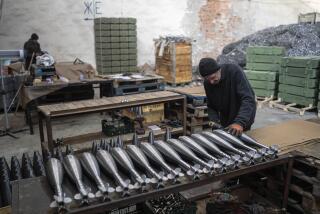To Azerbaijanis, a Tank by Any Name Is Still a Threat : Soviet Union: Armenians in troubled Nagorno-Karabakh have purchased 14 without guns and turrets as ‘agricultural towing vehicles.’
- Share via
MOSCOW — With their heavy armored plating and tractor treads, they may look like tanks. With the full-throated roar of their engines, they sound like tanks. And, as they speed cross-country at 20 m.p.h., virtually unhindered by the hilly terrain, they certainly move like tanks.
But, in the disputed territory of Nagorno-Karabakh in the southern Soviet Union, these tank look-alikes are officially designated “agricultural towing vehicles.”
Anticipating further troubles with their Azerbaijani neighbors, Armenians in Nagorno-Karabakh have purchased 14 surplus T-54 main battle tanks from the Soviet Defense Ministry and deployed at least half of them last month, the newspaper Sovetskaya Rossiya reported Thursday.
Although their guns and turrets had been duly removed by military workshops before delivery to Nagorno-Karabakh, the tanks remain very formidable fighting vehicles, able to withstand automatic weapons and even artillery fire, to crash through walls and other obstacles and to travel easily across the territory’s difficult terrain, according to the newspaper.
Moreover, despite their official designation as agricultural vehicles, the tanks have been specially equipped at the Armenians’ request with reinforced armored plating, high-power military radios and night-vision devices, Sovetskaya Rossiya reported.
And, although the order was placed by the chief engineer of the agricultural department of Nagorno-Karabakh, an autonomous region in the southern Soviet republic of Azerbaijan, it appears to have been approved, financed and overseen by the road transport ministry of the neighboring republic of Armenia.
Armenia and Azerbaijan have been in virtual conflict over Nagorno-Karabakh for two years, and the centuries-old enmity between their peoples has led to direct hostilities, involving armed militias on both sides, along their common border and in and around Nagorno-Karabakh in January. The contract for the decommissioned tanks, originally signed in December, 1989, led to a larger contract signed in February, but only seven of the tanks were actually delivered before higher authorities intervened.
Recalling “how much concern and how much effort” went into the recovery of four tanks that were hijacked by militiamen while being delivered to soldiers at one Azerbaijani town in January, Sovetskaya Rossiya commented, “Even without their guns and ammunition, these tanks could do a lot of damage to the other side.”
In January, Armenian militias methodically attacked ordnance depots, emptying them of everything from pistols and rifles to mortars, howitzers, anti-aircraft artillery and armored vehicles. Azerbaijanis similarly built up large arsenals of weapons.
“Both sides would clearly love to have tanks and armored vehicles,” Sovetskaya Rossiya continued, “and they are ready to go to any lengths to obtain them. . . . The question is how they managed to do so.”
That answer is long, involved and, as Sovetskaya Rossiya’s team of three correspondents found, often hard to believe.
As told by army officers assigned to sell off the Defense Ministry’s surplus equipment and material, Nagorno-Karabakh sent the chief engineer of its agricultural department to a sales fair in December and later signed a contract to buy 14 decommissioned T-54 and T-55 tanks, which it said were to be used to tow agricultural equipment once their turrets and guns were removed.
That such tanks cost four times as much as a heavy-duty tractor, required special fuel and lubricants obtainable only through military channels and would still last only a few years, not a decade, was of little consequence, the paper said.
“Economically, this vehicle is hopeless as agricultural equipment,” an army colonel said. “The tank consumes far more fuel than any tractor, and its 500 horsepower just does not have near the pull of a tractor with only 106 horsepower.”
Another scam, uncovered only at the last minute, involved the shipment of a dozen of the Soviet Union’s newest tanks to a Middle East purchaser, which would pay for them with shipments of computers and condoms. That already had imperiled the government’s military conversion program.
But the Nagorno-Karabakh chief engineer, R. Ayriyan, signed a $1.7-million contract in December to buy 14 tanks and asked that they be fitted with additional armor plating and other equipment. He later pledged to buy a total of 40 this year.
The military, under heavy political pressure to convert as much of its equipment as possible to civilian use, should not be blamed for signing such a contract, Sovetskaya Rossiya said, noting that its original intention had been to write an article about “how tanks are changing their profession” in a time of peace.
But the intended use in Nagorno-Karabakh--namely, the apparent development of a local armored corps which could be used against Soviet security forces as well as neighboring Azerbaijanis--showed the dangers of unsupervised sale of weapons, the paper commented.
“If that is conversion, what are we going to tell the Americans?” the correspondents ask, recalling that the Soviet Union has made a major issue out of its reduction of tank forces. “But then, what are we going to tell our own countrymen down in the Caucasus?”
More to Read
Sign up for Essential California
The most important California stories and recommendations in your inbox every morning.
You may occasionally receive promotional content from the Los Angeles Times.













